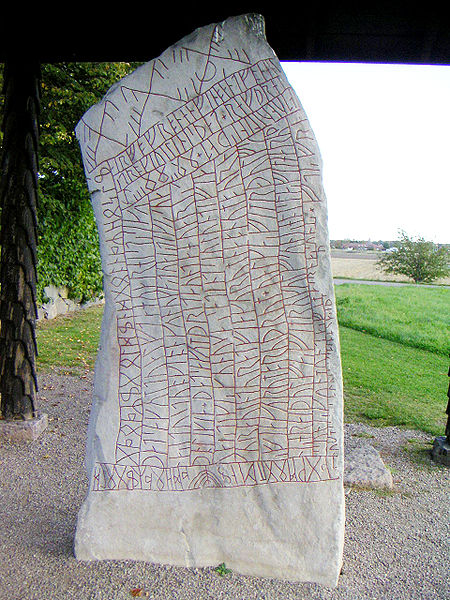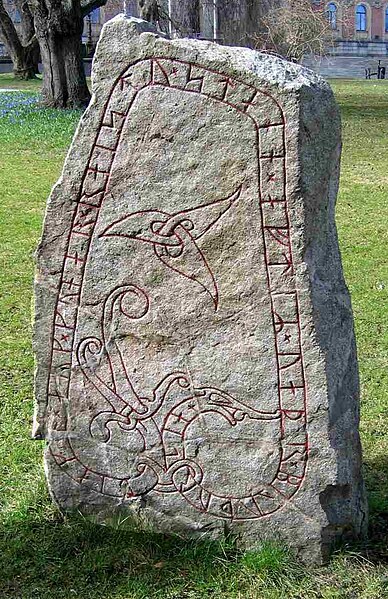A new book acquired by the Thammasat University Library should be helpful for students who are interested in linguistics, sociology, communication studies, and related subjects.
Revival of the Runes: The Modern Rediscovery and Reinvention of the Germanic Runes is about forms of writing that existed before the Roman alphabet was created by Latin culture.
Over 2100 years ago, people in Europe wrote in runes, a noun derived from Old Norse, Old High German, and Celtic terms meaning a dark mysterious statement, secret conversation or charm.
Some historians suggest that the runic alphabet may have been adapted from Greek writing, with letters redesigned to be easier to cut into wood or stone.
TU students who are fans of the Lord of the Rings films and books, which are available in the TU Library collection, will recall that in J. R. R. Tolkien’s novel The Hobbit (1937), Anglo-Saxon runes are used on a map to indicate its connection to the Dwarves.
For the rest of The Lord of the Rings, Tolkien invented his own rune-like alphabet, and runes are often seen in fantasy literature and video games.
TU students who are Harry Potter fans may also remember that The Study of Ancient Runes (commonly shortened to Ancient Runes) was an elective course at Hogwarts School of Witchcraft and Wizardry and presumably Ilvermorny School of Witchcraft and Wizardry, that could be taken by students third year and above.
The Harry Potter books in English and Thai translation, as well as the films and academic studies inspired by them, are all in the collection of the TU Library.
Classwork and homework involved plenty of practice translating runes, and the Ordinary Wizarding Level (O.W.L.) or standardized subject-specific test taken during Hogwarts students’ fifth year, administrated by the Wizarding Examinations Authority, involved translating something written in runes into English. Hermione Granger used Spellman’s Syllabary to translate her homework.
Hermione observed about the symbol of the Deathly Hallows: It isn’t a rune and it’s not in the syllabary either. All along I thought it was a picture of an eye, but now I don’t think it is!
Spellman’s Syllabary was a textbook used in the class Ancient Runes at Hogwarts School of Witchcraft and Wizardry. The book contained information on runes and their meanings, and could be used to translate runes into modern English. The edition owned by Hermione Granger was written by Rosana Amorim, but may have been based on an earlier edition by Spellman.
Hermione owned a copy of this book because she took Ancient Runes. In her fifth year, she consulted it for homework while idly discussing the second Quidditch match of the season with Fred Weasley, George Weasley, and Harry Potter. The following year, Hermione took her copy out of her bag while discussing the cursing of Katie Bell with Harry Potter and Ron Weasley, presumably so she could do her Ancient Runes homework.
After the death of Alastor Moody in 1997, Harry, Ron, and Hermione gathered in Ron’s bedroom at The Burrow to discuss their plan to hunt Lord Voldemort’s Horcruxes. Harry speculated on the fate of Moody’s body, causing Hermione to burst into tears over her copy of Spellman’s Syllabary. Hermione chose during this meeting to take the book with her on the quest in case she needed to translate runes.
Hermione later used the book to translate the wizarding fairytale collection The Tales of Beedle the Bard from the original runes.The absence of the sign of the Deathly Hallows in the syllabary led her to believe that the symbol might have special significance.
The course was taught by Professor Bathsheda Babbling during the 1990s at least, and it was the study of runic scriptures, or Runology. Ancient Runes was a mostly theoretical subject that studied the ancient runic scripts of magic.
Among other references to runes in the Harry Potter series is The Rune Dictionary, used to aid witches and wizards in the translation and understanding of runes. Students who take Study of Ancient Runes at Hogwarts use this book to decipher the meaning of runes.
In 1994, Harry Potter also used the book to help practice the Summoning Charm in preparation for the first task of the Triwizard Tournament.
Hermione Granger was known to own a copy as she used it to try and translate The Tales of Beedle the Bard left to her by Albus Dumbledore in 1997.
Advanced Rune Translation was a book about Rune Translation by Yuri Blishen. It was a required textbook for Study of Ancient Runes, an elective course at Hogwarts School of Witchcraft and Wizardry.
Hermione Granger was reading a copy of this book after her trip to Diagon Alley before the start of her sixth year at Hogwarts.

People who study runes are specialists in runology.
As TU students know, the word ending ology is used to name a field of study.
Here are some English words ending in ology that refer to other fields of study:
- methodology
- microbiology
- mixology
- mythology
- musicology
- museology
- meteorology
- metapsychology
- immunopathology
- immunology
- ideology
- iconology
- ichthyology
- hymnology
- hydrology
- kinesiology
- martyrology
- lexicology
- lepidopterology
- pharmacology
- paleontology
- pathology
- parapsychology
- papyrology
- ornithology
- neuropsychology
- nephrology
- ophthalmology
- oenology
- cardiology
- campanology
- cosmology
Runology is the study of the runic alphabets, runic inscriptions, runestones, and their history, forming a specialized branch of Germanic linguistics.
The oldest inscriptions are found in Denmark and northern Germany.
In some ancient literature, runes are described as having the power to bring dead things back to life.
Some specialists argue that early runes were not just used as a simple writing system, but also as magical signs for charms.
Other researchers point out that no direct evidence survives that runes were used for magical purposes.
In the modern world, TU students will be familiar with Bluetooth technology, a short-range wireless communications technology to replace the cables connecting electronic devices, allowing a person to have a phone conversation through a headset, use a wireless mouse and synchronize information from a mobile phone to a PC, all using the same core system.
The logo of Bluetooth wireless technology was inspired by runes.
Scandinavian engineers Sven Mattisson and Jim Kardach were working on the technology in the late 1990s when they named their company after a Viking king of Denmark, Harald Bluetooth Gormsson. The king was called Bluetooth because one of his teeth was dead and looked blue.
King Harald Bluetooth Gormsson united Norway and Denmark, and the founders of Bluetooth were trying to unite the personal computer and cellular industries by short-range wireless linkage.
The Bluetooth logo has two letters, with the Nordic runes for the letters H and B standing for Harald Bluetooth.

(All images courtesy of Wikimedia Commons)


